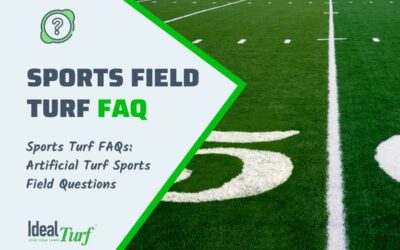Texas Water Crisis: How Does Artificial Turf Conserve Water During Droughts & Water Shortages?

The prolonged periods of drought in Texas have resulted in strict water regulations throughout Central Texas in recent years.
With the Colorado River, a major water source for Austin, reaching historically low levels, and the Highland Lakes frequently dropping below 40% capacity, it is more crucial than ever to conserve water.
Maintaining lush green lawns may appear to be an unattainable luxury considering the water scarcity in Texas.
However, by installing artificial turf, homeowners in Texas can maintain beautiful landscapes without the excessive water consumption of natural grass.
Artificial turf offers a flexible and environmentally friendly option for lawns that can significantly decrease outdoor water usage.
By transitioning to artificial turf, homeowners can contribute to water conservation while avoiding the challenges of keeping real grass alive in the hot Texas climate.
In this post, we’ll explore the water and chemical requirements of natural grass vs. artificial grass.
We’ll also provide some tips on how to ensure you’re doing your part to help Texas conserve its natural sources of water.

The Growing Water Crisis in Texas
Texas, known for its vast landscapes and diverse ecosystems, has been grappling with a growing water crisis in recent years. The Lone Star State faces an ever-increasing demand for water, driven by population growth, industrial development, and agricultural needs. This heightened demand has put immense pressure on the state’s water resources, leading to concerns about water scarcity and the need for sustainable solutions. In the face of this crisis, artificial turf emerges as a practical and eco-friendly alternative that can significantly contribute to water conservation efforts.
What is Causing the Texas Water Shortage?
In the next few years, the increasing population and growth of urban areas will put excessive pressure on Texas’ water sources. Flow in almost 75% of Texas rivers and water levels in all our major aquifers are decreasing. According to the State Water Plan, if no action is taken, Texas will be confronted with a statewide water scarcity that could result in an estimated $151 billion in annual economic losses by 2070.
Additionally, with 60% of the state’s water usage currently dedicated to supporting Texas’ leading agricultural industries, such as farming and ranching, only 40% is left to generate energy, cater to expanding cities, and maintain the natural balance of the environment. Meanwhile, more frequent and severe droughts, as well as devastating floods, are adding further uncertainty to the future of Texas’ water resources.

How Does Artificial Grass Help to Conserve Water?
Artificial grass, often referred to as synthetic turf or fake grass, has gained popularity as a landscaping solution due to its remarkable water-saving properties. Unlike natural grass, which requires regular watering to maintain its lush appearance, artificial turf provides a sustainable landscaping option that helps conserve water resources. Let’s explore this by comparing the water requirements and chemical needs of artificial grass vs. natural grass.
Comparing Water Usage of Natural Grass vs. Artificial Grass
Natural Grass Water Usage
Traditional grass lawns are notorious for their water-thirsty nature. It’s important to understand how much water is typically used on natural grass lawns. According to the Environmental Protection Agency (EPA), a typical household in the United States uses about 320 gallons of water per day, with up to 70% of that water used outdoors for activities such as watering lawns and gardens.
In the U.S., 9 billion gallons of water are used everyday just to water lawns (that’s an average of 27 gallons of water per person, per day.) Around 50% of this water is wasted due to overwatering that results from inefficient irrigation methods. This means in the US alone, 1.65 trillion (that’s trillion with a T) gallons of drinkable water is wasted each year.
In Texas, where the climate can be arid and water scarcity is a pressing concern, maintaining a lush, green lawn with natural grass can be an uphill battle. On average, a 1,000 square-foot natural grass lawn will need 623 gallons of water per week for at least 6 months out of the year, depending on local climate conditions and the type of grass. With large residential and commercial properties often featuring extensive lawns, the water usage for traditional grass can add up to significant amounts.
Artificial Grass Water Usage
In stark contrast to natural grass, artificial turf requires minimal irrigation to stay green and pristine. While you don’t need to water it like a natural grass lawn, synthetic grass benefits from the occasional rinse off. Rinsing an artificial grass lawn will require just 78 gallons per week (or 155 gallons for a biweekly hose-down).
Artificial grass installations typically involve the use of a well-designed drainage system that allows rainwater to pass through, preventing water accumulation. Additionally, artificial turf is designed with permeable backings that facilitate water drainage, reducing the risk of surface water runoff and wastage.
Installing synthetic turf is estimated to save up to 55 gallons of water per square foot annually compared to natural grass. This substantial reduction in water usage makes artificial turf a compelling option for homeowners, businesses, and municipalities looking to reduce their water footprint and contribute to water conservation efforts.
Comparing Chemical Usage of Natural Grass vs. Artificial Grass
Protecting the natural water resources here in Texas, and throughout the U.S. extends beyond the actual volume of water available. An increasing issue found in groundwater is the presence of chemicals like fertilizers, pesticides, herbicides, etc. Chemicals inevitably make their way into groundwater or waterways as runoff, which has far-reaching environmental effects. Let’s compare the chemical needs of artificial turf to those of natural grass.
Natural Grass Chemical Usage
Maintaining natural grass lawns often requires a range of chemical applications, including fertilizers, pesticides, and herbicides. Americans use roughly 80 million pounds of pesticides & fertilizers on their lawns each year. These chemicals are used to promote healthy growth, combat pests, and control weeds. However, their application comes with environmental consequences, as excess chemicals can leach into the soil and waterways, posing risks to both ecosystems and human health.
Pesticides and fertilizers can seep into groundwater and wreak havoc on streams and rivers. Several common lawn chemicals have been known to cause algal blooms and are toxic to fish and even pets. In Texas, the use of chemical fertilizers and pesticides has raised concerns about water contamination and its impact on aquatic ecosystems. This is particularly true in areas with a high concentration of residential lawns and golf courses.
Artificial Grass Chemical Usage
One of the environmental advantages of artificial turf is its non-reliance on chemicals. Synthetic lawns do not require fertilizers, pesticides, or herbicides to maintain their appearance. This not only reduces the potential for water pollution but also lessens the financial burden on homeowners and property managers who would otherwise invest in these costly chemicals for natural grass maintenance.
Moreover, the absence of chemicals on artificial turf makes it a safer and more eco-friendly option for families with children and pets. It eliminates the risk of exposure to harmful substances, offering peace of mind to those who value the health and well-being of their loved ones.

Why Conserving Water Matters
Conserving water is crucial, both for financial reasons and for the environment. Many people are unaware that clean drinking water is a valuable and scarce resource. Water conservation aims to ensure that there is enough water for everyone’s needs. Everything from growing food to personal hygiene requires water. Therefore, using water solely to maintain a lush yard is wasteful, especially in areas affected by drought.
The average American uses 100 to 175 gallons of water daily, and globally, humans consume about 4 trillion cubic meters of freshwater annually. Agriculture alone can use up to 75-90% of a region’s available freshwater – something to consider when thinking about watering your lawn!
How does artificial turf help? Well, the 6,000+ synthetic turf fields in the US save between 500,000 and 1,000,000 gallons of water each year. That adds up to over 3 billion gallons in just one year. Those numbers really start to add up.
Conserving Water Helps to Save Energy
Once water becomes contaminated, we need to be concerned about the process of water treatment. Water treatment facilities consume a significant amount of energy. A 2013 study found that water treatment uses approximately 30 billion kilowatt-hours of electricity annually, accounting for about 0.8% of the total electricity consumption in the US.
Our dependence on limited resources for both energy production and water purification necessitates careful and mindful usage. While the 0.8% of electricity used for water treatment may seem insignificant, when considering the overall energy consumption, any conservation efforts are a step in the right direction. Energy production can also lead to pollution and waste, having a negative impact on the environment. Saving energy not only saves money but also helps reduce environmental damage.

How to Help Conserve Water With Artificial Grass
Switch to an Artificial Grass Lawn
Once properly installed on a suitable foundation, synthetic grass maintains its vibrant green look without the need for any water. By eliminating the requirement for irrigation, the average home lawn can save thousands of gallons of water each year. When multiplied across neighborhoods and cities, artificial grass offers significant water conservation benefits. It’s an excellent ground cover for xeriscaping in drought-prone areas like Texas.
According to studies conducted by the Texas Water Development Board, replacing traditional lawns with artificial turf can result in a reduction of outdoor water usage by up to 70% in many cities. For homeowners who are mindful of water conservation, artificial turf is a great choice for landscaping in Texas. The water savings alone make artificial turf installations well worth considering.
Install an Efficient Drainage System
Effective drainage systems are crucial for sustainable landscaping practices and water conservation. Artificial turf installations are designed with drainage in mind, ensuring that water is efficiently managed without wastage.
The drainage system typically includes a base layer of crushed stone or gravel, which facilitates the rapid percolation of water. On top of this base, the artificial turf is installed, often with a perforated or fully-permeable backing that further enhances drainage capabilities. This setup ensures that water quickly moves through the turf, preventing puddles and surface runoff.
In addition to preventing water wastage, efficient drainage systems reduce the risk of waterlogged areas, which can be a breeding ground for pests and mosquitoes. This not only contributes to water conservation but also enhances the overall aesthetics and functionality of the landscape.

Key Takeaways on How Artificial Turf Helps to Conserve Water
The water crisis in Texas is a stark reminder of the urgent need for sustainable solutions to conserve this vital resource.
In this article, we’ve explored how artificial turf helps reduce water consumption and eliminates the need for harmful chemicals.
Artificial turf offers a range of benefits that make it a valuable tool in water conservation efforts.
By choosing artificial turf for landscaping, homeowners, businesses, and municipalities can make a positive impact on water conservation.
Not only does it save water, but it also offers long-term cost savings, reduces the carbon footprint associated with lawn maintenance, and provides a safer environment for families and pets.
As Texas and other regions around the world grapple with water scarcity, it’s essential that we embrace sustainable practices and technologies like artificial turf.
By doing so, we can collectively work towards a more water-efficient and environmentally responsible future.
The choice is clear: artificial turf is a key ally in the battle to conserve water and protect our planet’s most precious resource.
If you have any questions or you’re interested in discussing artificial turf for your home or business in Texas or Oklahoma, contact Ideal Turf.
To speak with our team simply click the “GET A QUOTE” button or feel free to give us a call at (800) 276-8587.

FAQ
Is Artificial Turf Environmentally Friendly?
Yes, artificial turf is considered environmentally friendly for several reasons. It significantly reduces water consumption compared to natural grass lawns, leading to water conservation. It also eliminates the need for chemical fertilizers, pesticides, and herbicides, reducing the risk of water pollution. It also doesn’t require the use of gas-powered equipment, reducing carbon emissions and lowering your carbon footprint. Additionally, some artificial turf materials are recyclable, contributing to sustainability efforts.
How Long Does Artificial Turf Last?
The lifespan of artificial turf varies depending on factors such as quality, usage, and maintenance. Typically, high-quality artificial turf can last 15 to 25 years or more with proper care. Regular turf maintenance, such as brushing to prevent matting and keeping it free from debris, can extend its longevity.
Is Artificial Turf Safe for Children & Pets?
Yes, artificial turf is safe for children and pets. It eliminates the need for chemical fertilizers and pesticides, reducing the risk of exposure to harmful substances. It also provides a clean and resilient surface for play and activities. However, it’s essential to ensure proper installation and choose artificial turf products that meet IPEMA safety standards.
Can I Install Artificial Turf Myself (DIY)?
While it’s possible to install artificial turf yourself, professional installation is recommended for the best results. Professionals have the expertise and equipment to ensure proper drainage, seams, and a smooth, even surface. DIY installation may save costs but can lead to issues if not done correctly, such as poor drainage or uneven turf. DIY installations often need to be corrected or completely redone by a professional. This ultimately leads to even higher artificial turf costs.
Recent Posts
- How Does Artificial Turf Help With Allergies Compared to Natural Grass?
- Artificial Turf Innovations & Advancements: The Future of Synthetic Grass
- The Top 10 Best Artificial Turf Backyard Putting Green Installers in & Around Lubbock, TX
- Types of Infill Materials Used on Artificial Turf: Which Infills Are Best for Children & Pets?
- The Top 10 Best Artificial Turf Backyard Putting Green Installers in & Around Oklahoma City, OK






